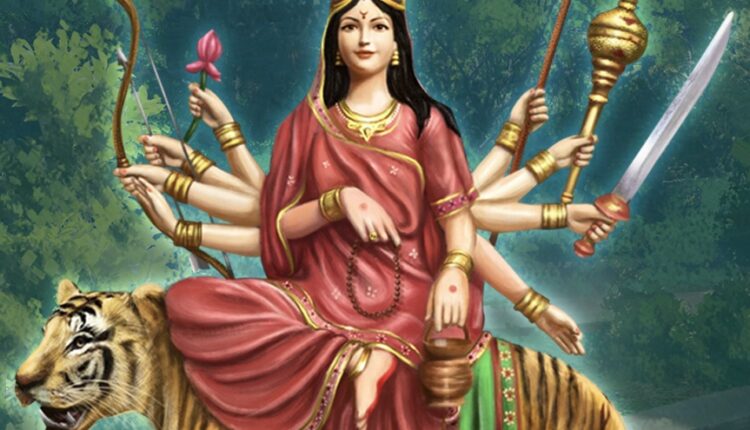The Nine Facets of Devi Durga: Know About Goddess Chandraghanta
Goddess Chandraghanta: The Divine Warrior of Power, Peace, and Protection
The nine-day festival of Navratri celebrates the nine avatars of Goddess Durga, each representing a distinct facet of the divine feminine energy. Among these forms, Goddess Chandraghanta holds a significant place as the third form worshiped on the third day of Navratri. Her name itself has profound meaning—Chandra refers to the moon, and Ghanta means bell. Chandraghanta is known for the half-moon shaped like a bell adorning her forehead, symbolizing her celestial power and divine grace.
Symbolism and Appearance
Goddess Chandraghanta embodies courage, serenity, and strength. She is depicted riding a tiger, signifying her dominance over fear and her power to protect devotees from harm. Her golden complexion radiates calmness and warmth, while her ten arms carry various weapons, including a trident, mace, sword, and bow, showcasing her warrior nature ready to combat evil. Despite her fierce appearance, her face remains calm, symbolizing the balance between ferocity in battle and inner tranquility.
The half-moon on her forehead also symbolizes time and cycles, connecting her to the cosmic rhythms that influence life on Earth. Bells are often associated with divine sound that wards off evil spirits, further emphasizing her protective nature.
Mythological Significance
The legend of Goddess Chandraghanta is tied to the story of her transformation from Goddess Parvati. Goddess Chandraghanta is a manifestation of Parvati after her marriage to Lord Shiva. Following the severe penance undertaken as Brahmacharini to win Lord Shiva’s heart, Parvati transformed into this form, symbolizing the transition from her peaceful nature into one of combat readiness to protect her devotees. After marrying Shiva, Parvati adorned her forehead with a half-moon, symbolizing balance and peace but also signaling her readiness to defend her loved ones and the universe from evil forces.
In many stories, she is known to have sounded her bell-like war cry, which terrified demons and sent shivers down their spines. Her roar of protection is said to have reverberated throughout the heavens, instilling fear in those who sought to harm the innocent. In the battle between good and evil, Goddess Chandraghanta stands as a beacon of justice and protection.
Spiritual Significance
Worshiping Goddess Chandraghanta helps devotees balance their emotional and spiritual energies. She is believed to remove negative energies and obstacles in one’s path, filling their life with peace, prosperity, and wisdom. Her blessings offer relief from mental stress and physical suffering, providing a path to internal harmony.
Chandraghanta’s fierce yet serene form encourages individuals to develop both inner strength and outer compassion. It teaches the important life lesson of balancing aggression and peace—knowing when to stand up for justice and when to maintain calm and poise.
Support Independent Journalism? Keep us live.
Association with the Manipura Chakra
Goddess Chandraghanta is closely associated with the Manipura Chakra, the energy center located in the navel region, which governs willpower, courage, and transformation. The Manipura Chakra is often referred to as the power chakra, controlling a person’s sense of personal strength and identity. When this chakra is activated through the worship of Chandraghanta, devotees experience heightened confidence, courage, and the ability to overcome difficulties.
Through the third day’s worship, the awakening of the Manipura Chakra allows for a release of negative energies, helping individuals grow stronger, more determined, and capable of tackling life’s obstacles. The energy from this chakra enhances not only physical strength but also mental clarity and emotional resilience, empowering devotees to make decisive actions aligned with dharma.
Mantras and Prayers
Devotees chant mantras to invoke her blessings and protection. One of the most powerful mantras dedicated to Goddess Chandraghanta is:
“Om Devi Chandraghantayai Namah”
This mantra, when chanted with devotion, helps purify the mind and body, allowing worshippers to experience peace while invoking the divine force to fight personal battles.
Goddess Chandraghanta represents the fusion of strength and compassion, symbolizing the balance that is necessary for overcoming life’s challenges. As one of the nine manifestations of Durga, her energy teaches us the importance of being both a protector and a nurturer. On the third day of Navratri, her blessings guide devotees to live a life of courage, dignity, and peace, reminding us that true strength lies in balancing both fierceness and grace.
By invoking the presence of Goddess Chandraghanta, one learns the art of standing up for righteousness, while maintaining inner tranquility—a powerful lesson for every seeker on the spiritual path.


Comments are closed.